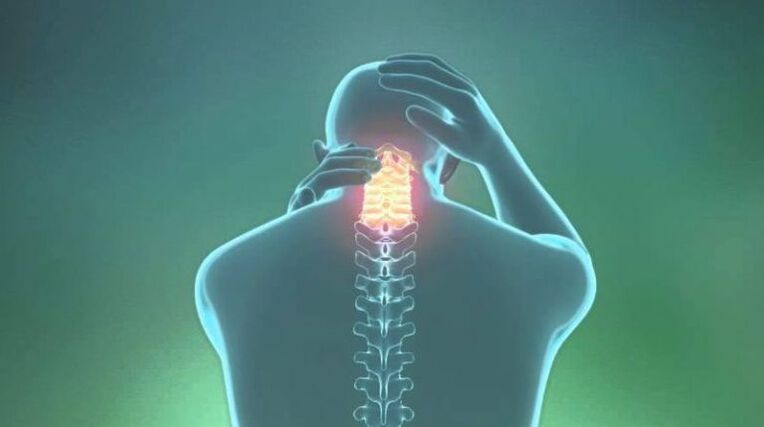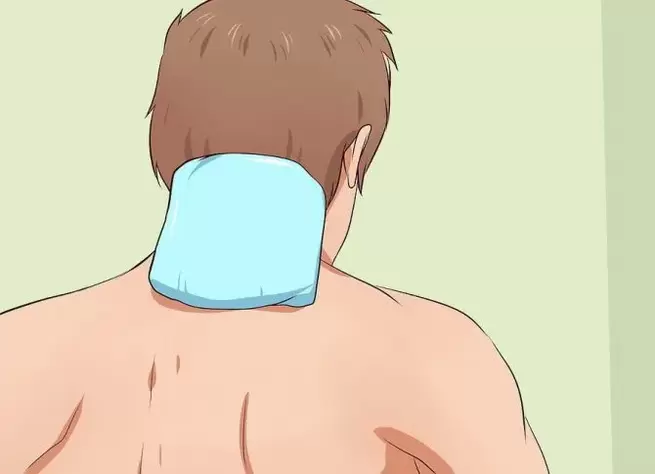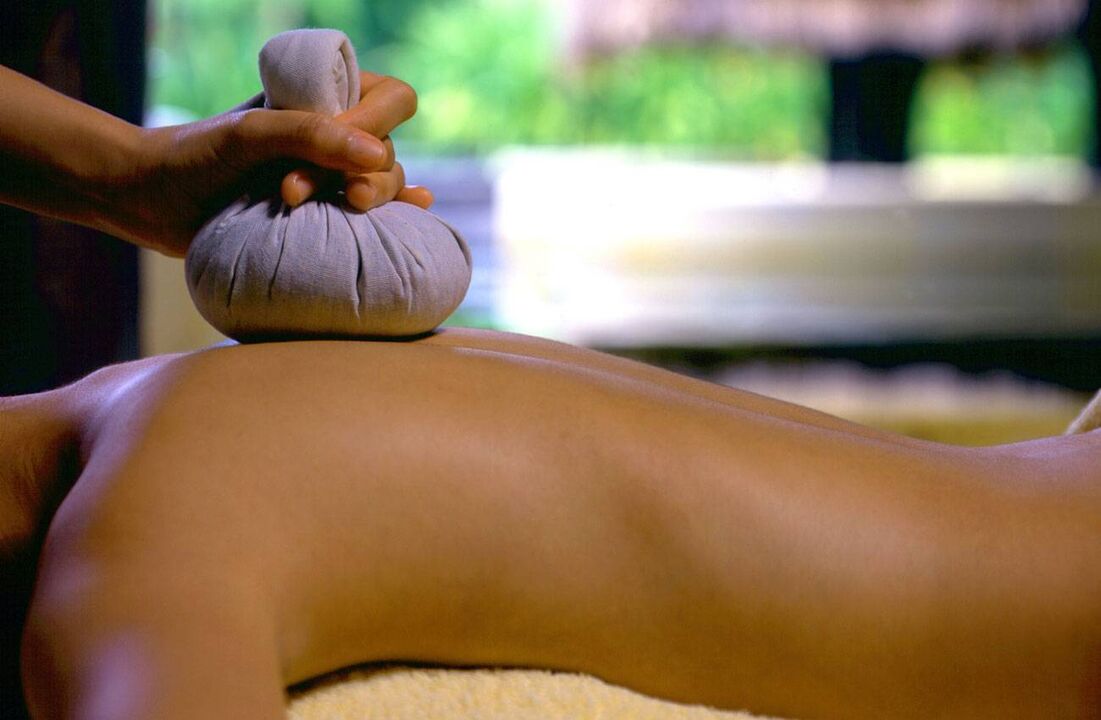
Osteochondrosis is one of the most insidious diseases of the musculoskeletal system. Its symptoms are often disguised in other diseases and bring many unpleasant and painful sensations. The occurrence of pathological changes in the cervical spine is associated with the influence of various factors.
Symptoms
Cervical osteochondrosis is accompanied by various symptoms. Headaches, tingling in the center of the chest or chronic fatigue - all these signs accompany dystrophic disorders of the cervical spine.
Symptoms of osteochondrosis:
- Dizziness, which sometimes leads to loss of consciousness or fainting.
- Crunching when trying to rotate or turn your head.
- Attracting pain and tingling in the shoulders, elbows or neck.
- Tingling in the arms and legs, from the tips of the toes down the entire limb.
- Unreasonable appearance of apathy and drowsiness. The feeling of accumulated fatigue continues even after a long sleep or passive rest.
- Tinnitus (tinnitus without apparent cause).
- Hearing loss or blurred vision.
- Pain in the sternum, with numbness of the hands or feet.
Important: the neck is one of the most important parts of the spine due to the accumulation of a large number of nerve trees. Even a slight displacement of the spine by 1-3 mm leads to a violation of blood circulation in the brain and can cause hypertension, migraine. Less often to hypoxia of the brain, stroke.
In the last 2 decades, doctors have noticed the appearance of osteochondrosis in young people. If earlier in the risk group were representatives of middle and old age, then at this time the disease is more common in people aged barely 20-30.
The danger of any symptoms of osteochondrosis lies in the fact that they are attributed to other diseases, and the appeal to specialized specialists is delayed. This allows the disease to become chronic and lead to irreversible damage to the anatomical structures of the cervical spine.
Causes of osteochondrosis
Each segment of the spine is built according to one principle: the soft pulp inside the vertebra absorbs all the structures of the segment, loses elasticity and becomes ossified. The pathological process affects the nerves and blood vessels.
To understand the causes of osteochondrosis, consider the problem from a medical standpoint.
> zxtable border = "1" cellpadding = "0" >Pathological changes in the vertebrae are accompanied by:
- Salt deposition in the nucleus pulposus.
- Penetration of vertebral structures into adjacent segments (hernia formation).
- Erasure and wear of the cervical spine segments.
- Ossification of the soft tissues of the joints.
Causes of osteochondrosis:
- Autoimmune diseases lead to degenerative processes in cartilage tissue.
- Infectious - the presence of pathogenic microorganisms leads to metabolic disorders in tissues and can cause pathological processes in the joints.
- Involutional - natural aging processes of the organism.
- Traumatic - the development of pathologies as a result of injury.
- Endocrine - hormonal disorders.
- Metabolic disorders - degenerative processes as a consequence of metabolic failures.
- Heredity - congenital pathologies of joint development, cartilage. anatomical disorders.
- Long stay in one position.
- Overweight - increases the load on the cervical region and can cause metabolic disorders.
- Nervous stress and prolonged exposure to a stressful situation.
- Rheumatism.
Folk methods of treating cervical osteochondrosis
In addition to conservative medical methods, folk methods are very effective in treating osteochondrosis of the cervical spine.
Herbal treatment
Phytotherapy is widely used in osteochondrosis of the neck for several reasons: a small number of contraindications, availability, high efficiency, cumulative effect of the use of tinctures and decoctions.
Preparation of decoction
In an enamel bowl, add 1 liter of water and add 5-6 tablespoons of the collection. Put the soup on low heat and cook for about 15 minutes.
Tinctures on alcohol from plants such as wild rosemary, burdock, mountaineer, elecampane, sage, yarrow are used for both external use and oral use. The principle of preparation of tinctures is as follows:
- Put 2-3 tablespoons of crushed herbs in a 250 ml container and add medical alcohol
- The infusion is kept in a cool and dark place for at least 14 days. All the above plants are suitable for cooking.
Preparation of the infusion: 4-6 tablespoons of crushed herbal raw materials pour into a 1 liter jar and pour boiling water. Cover the jar and leave for 24 hours in a dark place.
Compresses
The simplest method of treatment is the use of bischofite coatings, saline. high efficiency of the method is time-tested, the main principle of treatment is regularity and long-lasting effect. Soft fabric bandages or bandages are applied to the neck for a long time.

Salt compression: prepare a 10-11% salt solution (100 g per 1000 ml of water). In the resulting solution, moisten the gauze folded in several layers and apply to the neck. Put polyethylene on top and wrap with a warm scarf. Wraps must be done daily for about 10-14 days 1-2 times a day.
Fats
You can fight cervical osteochondrosis with homemade fats. For their preparation are used: herbs, plant roots, vegetable oils and products of animal origin - fats, poisons, bile, eggs.
Fat recipe:
- Mix yarrow, lavender, horsetail, dandelion roots (previously crushed) in equal proportions.
- Pour 2-3 tablespoons of the collection with boiling water and simmer on low heat for 5 minutes, stirring constantly.
- After cooling, mix the resulting mixture with 75 g of any vegetable oil and 75 g of animal fat until a homogeneous mass is obtained. Rub in the neck for 4-5 minutes 2-3 times a day.
Rubbing
Rubbing will help relieve neck pain in osteochondrosis. The effectiveness of this method lies in the fact that it has a complex effect. Rubbing the neck with the use of tinctures and ointments is effective in exacerbations and complex therapy. Biologically active substances easily penetrate into tissues due to mechanical action on the skin.
Rubbing from the fat (recipe is given above): take a small amount of fat and rub it into the palms. Then, with intense stroking movements, rub the ointment into the neck, after which it is necessary to insulate with a woolen scarf. Perform the procedure for at least two weeks in a row 1-2 times a day.
warming up
This method of exposure is used in cervical osteochondrosis to get rid of toxins accumulated in cartilage tissue, improve microcirculation of blood and lymph. Herbal baths, sauna, special heating pads, baked or boiled potatoes (in the form of mashed potatoes and honey cakes), bags of salt or sand are suitable for heating. After heating, the application of tinctures, ointments and compresses is more efficient.

To warm up, you will need sea salt and a bag made of thick natural fabric - better than linen. The salt needs to be heated in a pan and poured into a bag. Apply to the affected area 2-3 times a day. After the procedure, wrap your neck with a warm scarf and do not go outside, especially in the cold season.
Massage
This method is used only in the period of remission - in the absence of sharp pain and other acute symptoms of osteochondrosis.
The healing properties of the massage have long been known and are one of the best ways to remove osteochondrosis from the neck. Different massage techniques allow you to relieve muscle cramps that surround the segments of the spine:
- acupressure;
- classical;
- can;
- vacuum;
- Thai;
- self-massage.
Such an effect involves improving local blood circulation, relieving swelling, eliminating pain in the cervical region, improving tissue metabolism, restoring mobility of the cervical region and resuscitating atrophied muscles.
Self-massage for osteochondrosis is performed sitting or standing, the back is straight, the feet are shoulder-width apart. You can use one or two hands for the following techniques:
- Rubbing neck and collar with palms to warm up.
- Grasp the neck with your hands so that your thumbs are in front and the others are behind. In this position, hold four fingers from the spine to the periphery along the entire neck and neck area for 2-3 minutes.
- Circular movements of the fingers with pressure, covering as much of the neck surface as possible. Continue for 1-3 minutes.
- Vertical rubbing along the spine with fingertips - 1-2 minutes.
Gymnastics for osteochondrosis
It is almost impossible to cure osteochondrosis quickly, but special exercises will help speed up the recovery process.
A set of exercises for osteochondrosis of the cervical spine includes:
- Head rotations left and right - perform 5-6 repetitions in both directions, gradually increasing the amplitude.
- Raising and lowering the shoulders - 10-15 times.
- The head tilts left and right - 10-12 times in both directions.
- Stretching your head forward - in a standing position, stretch your head as far as possible, and then return to the original position. Do 10-15 reps.
- Cobra: Stand on all fours and gently stretch your head forward, straightening your legs and lifting your head up. Try lowering your hips to the floor. Lock in this position for a few seconds and slowly return. Repeat 4-9 times.
The last exercise helps to relax the muscles of the cervical region, restore the blood supply and remove pinching of blood vessels and nerve endings.
All exercises are performed slowly, smoothly and with ever-increasing amplitude. The number of repetitions and approaches is determined individually.
Diet for cervical osteochondrosis
With joint damage, the diet should be balanced and fractional - 5-6 times a day in small portions.
Limit your intake of salt, simple carbohydrates, spicy and fried foods.
The diet should include foods high in calcium, magnesium, phosphorus - these are cabbage, fish, meat, vegetables in stewed or baked form.
To effectively fight cervical osteochondrosis, increase your intake of clean water (at least two liters a day).
Prevention
The disease is easier to prevent than to cure. To reduce the risk of osteochondrosis, take the following preventative measures:
- use a comfortable place to sleep - orthopedic mattresses and pillows;
- engage in regular physical activity;
- work in a properly organized place under the condition of sedentary work;
- with static body position, take breaks for gymnastics;
- do not overeat;
- do not carry bags on one shoulder.
Contraindications
The main contraindications are:
- physical overload from a long stay in a static position;
- intentional cracking of the joints in the neck;
- consumption of large amounts of sweets and starchy foods;
- weightlifting;
- sleep on a soft mattress and a large pillow;
- hypothermia of the cervical region.
The treatment of osteochondrosis should be complex. A combination of different means and methods of therapy, along with recommendations on diet and physical activity, can alleviate cervical chondrosis. Despite the effectiveness of alternative therapies, seek the help of an orthopedist or osteopath in a timely manner, as self-medication can pose a health risk.


















